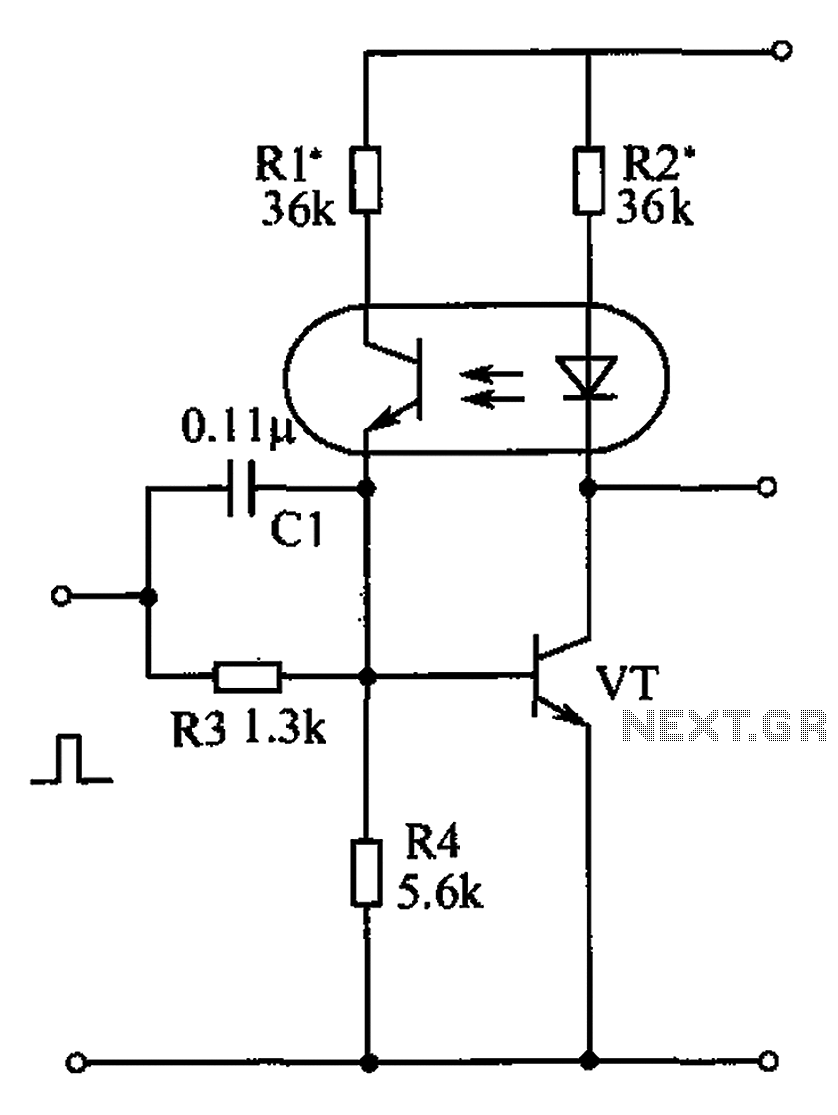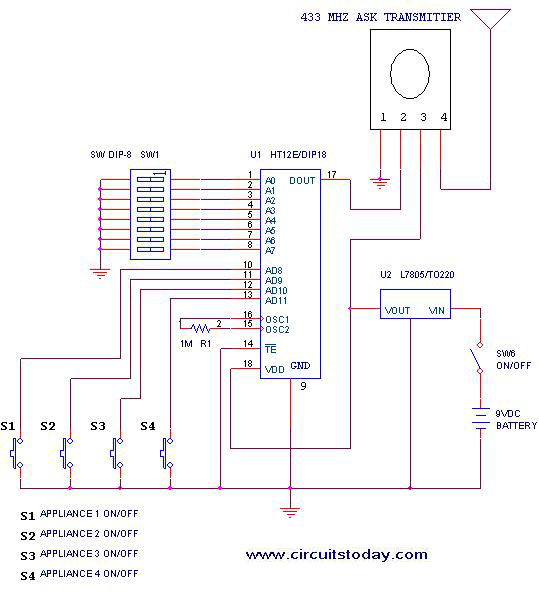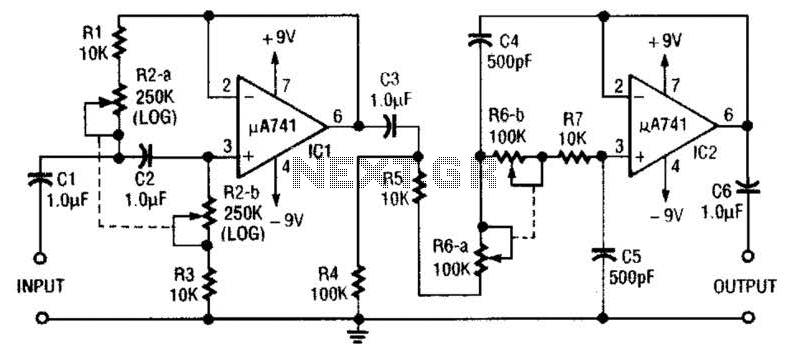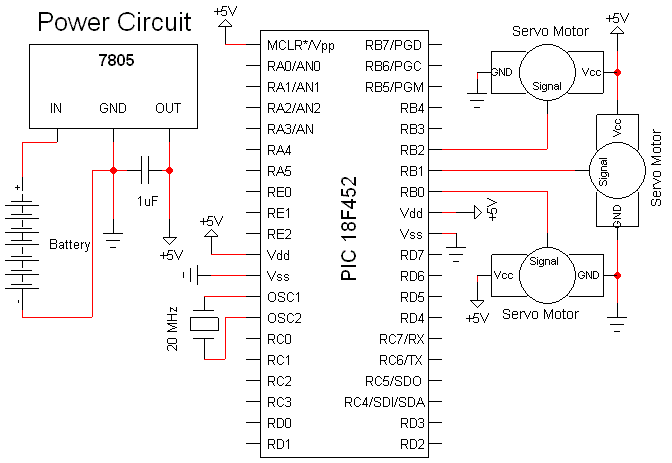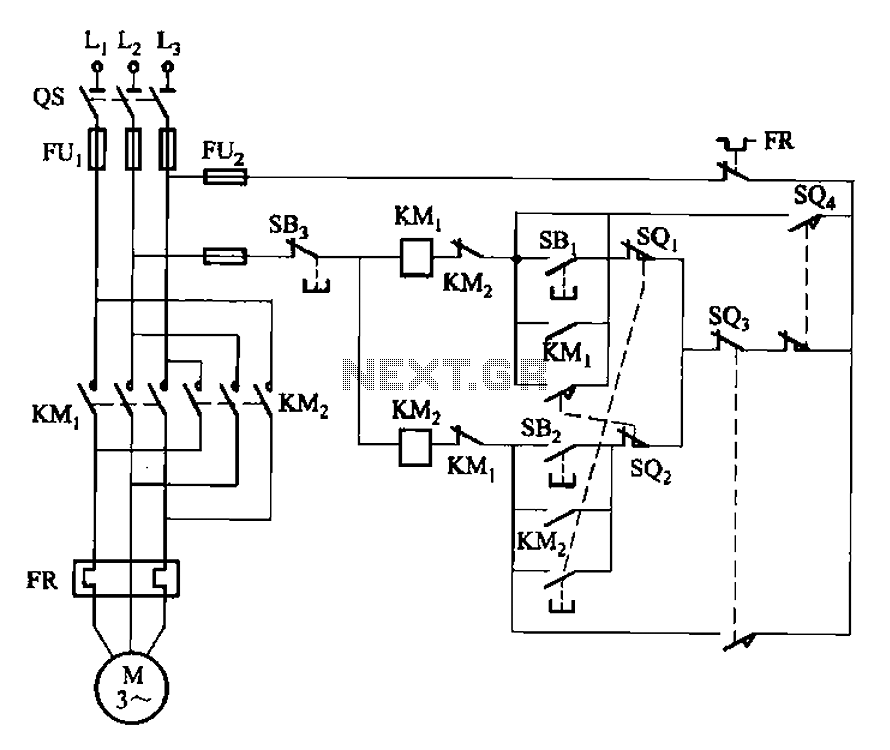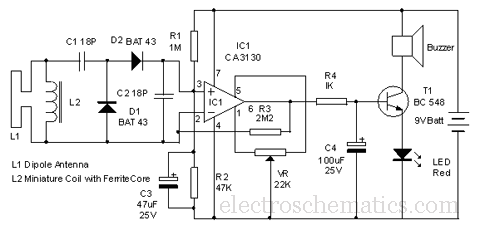
Eggs warming control circuit
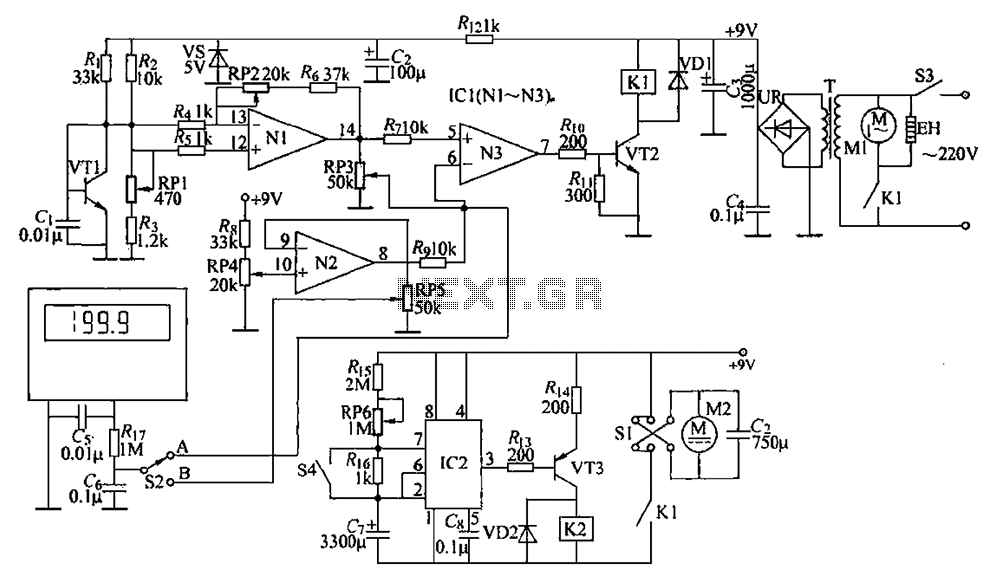
The circuit is illustrated. It includes a DC power circuit with a power switch (S3) that converts 220V AC voltage through a buck converter (T), a rectifier (UR), and filter capacitors (C3 and C4) to generate a +9V output. This voltage supplies the control circuit for the Kl drive, a buffer amplifier circuit, and an automatic egg turning mechanism. The +9V output is also regulated down to +5V through a Cz voltage regulator for the temperature detection control circuit. The egg turning mechanism is activated by a resistor (R) and a potentiometer (RP6), along with capacitors (G, 6). The integrated circuit (IC2), transistor (VT3), diode (VD2), relay (K2), limit switches (S1, S4), and a trigger switch for the DC motor (M2) are integral components. IC2, along with surrounding RC components, forms an astable circuit that controls VT3, VD2, K2, and M2. The circuit also includes a temperature sensor (VT1) to monitor the incubator's internal temperature, with an emitter voltage that varies with temperature. The resistance of RP4 is used to set the temperature control. Adjustments to RP1 and RP2 allow for changes in the emitter voltage of VT1 based on temperature variations. During operation, if the ambient temperature is low, the control amplifiers (N1 and N3) output high signals, causing VT2 to conduct and activate the relay (Kl) to power the fan motor (Ml) and heater (EH). When the temperature exceeds the set control level, the output from N1 and N3 goes low, deactivating VT2, releasing Kl, and stopping the fan and heater. This feedback loop maintains a consistent temperature in the incubator. Adjustments to RP3 and RP5 can enhance the temperature display accuracy. Upon power-up, since the voltage across capacitor G is initially low, IC2 outputs a low signal, cutting off VT3 and preventing K2 from activating, which stops M2. As G charges through resistors R1T, RP6, and Ru, the voltage at IC2's input gradually rises. Once the voltage across C7 exceeds 6V (approximately after 2 hours), IC2 flips, causing VT3 to conduct and energizing K2 to operate M2, which tilts the hatching plate to turn the eggs. The timing of this automatic egg turning can be adjusted using RP6. A trigger mechanism ensures that when the hatching plate tilts to a specific angle (about 70 degrees), it activates limit switch S1, changing the polarity supplied to M2. Simultaneously, limit switch S4 activates, allowing IC2 to discharge G rapidly. If the voltage across G drops below 3V, IC2 resets, turning off VT3 and stopping M2. As G charges again through resistors R1 and RP6, the process repeats, allowing for the opposite tilt of the hatching plate to continue the egg turning process.
The circuit employs a DC power supply that converts 220V AC into a stable DC output, essential for powering various components. The buck converter efficiently reduces voltage while minimizing heat generation. The rectification and filtering stages ensure that the output is smooth and free of ripple, critical for sensitive electronic circuits. The temperature control utilizes a negative temperature coefficient (NTC) thermistor, which provides a precise voltage drop corresponding to temperature changes, allowing for accurate monitoring and control of the incubator environment.
The control logic is implemented using an astable multivibrator configuration with the integrated circuit (IC2), which coordinates the operation of the motors and heating elements based on temperature feedback. The relay (K2) serves as a switching mechanism to control high-power components, ensuring that the low-power control circuit remains isolated from high voltage. The use of limit switches enhances safety by preventing mechanical overload and ensuring that the system operates within designated parameters.
Furthermore, the adjustable resistors (potentiometers) allow for fine-tuning of both the temperature set point and the timing of the egg turning mechanism, providing flexibility in operation. This design is particularly useful in incubator applications where maintaining stable conditions is critical for successful hatching. The feedback loop created by the temperature sensors and control amplifiers ensures that the system can respond dynamically to changes in the environment, maintaining optimal conditions for egg incubation. Circuit is shown. (1) DC power circuit power switch S3, 220v AC voltage by T Buck, UR rectifier, C3 and C4 filter, generating + 9V voltage, supply Kl drive control circuit, a b uffer amplifier circuit and automatic over eggs. + 9V voltage also by RJ. Limiting blood pressure, and after filtering Cz vs regulator for temperature detection control circuit provides + 5V operating voltage. (z) circuit automatically turn the eggs automatically turn the eggs circuit by the resistor R.. ~ R. Potentiometer RP6, capacitance G, 6, when the base integrated circuit IC2, transistor VT3, diode VD2, relay K2, limit switches S1, S4 and trigger switch DC motor M2 components.
Wherein IC2 and outer circumference RC components astable circuit fVT3 and R1l, RI., VD2, K2 and Sl composition M2 control circuit. + (3) provided VT1 temperature as a temperature sensor for detecting the temperature inside the incubator, its emitter (b, e between poles) with the voltage drop increasing temperature (temperature coefficient of - 2mV/).
RP4 used to set the temperature control. Adjustment RP1 and RP2 of resistance, can change VT1 emitter voltage varies with temperature slope. (4) during operation in low ambient temperature incubation tank set RP4 dry when the temperature control, the amplifier Nl and N3 output high, so that VT2 saturated conduction, Kl pull power, and its normally open contact connected, fan motor Ml and the heater EH power work. Hatch inside when the ambient temperature exceeds the set temperature control amplifier Nl and N3 output low level, so that VT2 end.
Kl release, the normally open contact is disconnected, and the heater fan motor Ml EH stop working. This process again and again, so that hatch inside temperature constant set temperature. Adjusting section RP3 and RP5 resistance, adjustable display accuracy of the temperature. In the instant power-on, since the voltage across the G mutation can not, IC2s feet and feet low, feet high output, VT3 cut stop, K2 is released, M2 does not work. Followed by G R1T, RP6 and Ru charged and the potential foot 1C2 feet and gradually rise. When the voltage across c7 charge to 6V above (approximately 2h), the inner circuit IC2 flip, pin goes low, so VT3 conduction.
K2 through electric pull its normally open contact connected, so that M2 is energized to rotate through the reduction of the discharge device and pull sectional hatching eggs hatch plate to tilt in one direction, turn the eggs had completed work. Adjustment RP6 resistance, can change the automatic Ao egg time. j trigger mechanism when hatching plate tilted to an angle (about 70.) When installed on deceleration traction sheave makes Sl normally open contact connected to the normally closed contacts to open, so that the rate of the M2 supply polarity change, while S4 is turned on at the moment, so 1C2 feet inside the discharge power circuit work for, G rapid discharge, when G is less than the voltage across the 3V, IC2 the pin goes high, so VT3 deadline, K2 release, the normally open contact head off, so that M2 is stopped.
Then G passed Ris, RP6 and Ris slow charging, when the voltage across the charge to G above 6V, IC2 inner circuit and flip, pin output low, the VT3 conduction, K2 pull power, and its normally open contact head is turned, so that M2 is energized to rotate by means of the discharge reduction and traction hatching eggs hatch plate in the opposite direction of tilt, turn the eggs to complete the action. When hatching plate tilted to a certain angle, the trigger mechanism is mounted on the traction sheave deceleration also allows Sl normally open contacts disconnect normally closed contact then on, so that the rate of the M2 supply polarity change, but at the same time silent turned about to be triggered so that IC2s output feet inside the discharge circuit, G rapid discharge when the voltage across the S7 lower than 3V, IC2 the pin goes high, so VT3 deadline, K2 release, which normally open contact breaking open, so that M2 and stops.
The circuit employs a DC power supply that converts 220V AC into a stable DC output, essential for powering various components. The buck converter efficiently reduces voltage while minimizing heat generation. The rectification and filtering stages ensure that the output is smooth and free of ripple, critical for sensitive electronic circuits. The temperature control utilizes a negative temperature coefficient (NTC) thermistor, which provides a precise voltage drop corresponding to temperature changes, allowing for accurate monitoring and control of the incubator environment.
The control logic is implemented using an astable multivibrator configuration with the integrated circuit (IC2), which coordinates the operation of the motors and heating elements based on temperature feedback. The relay (K2) serves as a switching mechanism to control high-power components, ensuring that the low-power control circuit remains isolated from high voltage. The use of limit switches enhances safety by preventing mechanical overload and ensuring that the system operates within designated parameters.
Furthermore, the adjustable resistors (potentiometers) allow for fine-tuning of both the temperature set point and the timing of the egg turning mechanism, providing flexibility in operation. This design is particularly useful in incubator applications where maintaining stable conditions is critical for successful hatching. The feedback loop created by the temperature sensors and control amplifiers ensures that the system can respond dynamically to changes in the environment, maintaining optimal conditions for egg incubation. Circuit is shown. (1) DC power circuit power switch S3, 220v AC voltage by T Buck, UR rectifier, C3 and C4 filter, generating + 9V voltage, supply Kl drive control circuit, a b uffer amplifier circuit and automatic over eggs. + 9V voltage also by RJ. Limiting blood pressure, and after filtering Cz vs regulator for temperature detection control circuit provides + 5V operating voltage. (z) circuit automatically turn the eggs automatically turn the eggs circuit by the resistor R.. ~ R. Potentiometer RP6, capacitance G, 6, when the base integrated circuit IC2, transistor VT3, diode VD2, relay K2, limit switches S1, S4 and trigger switch DC motor M2 components.
Wherein IC2 and outer circumference RC components astable circuit fVT3 and R1l, RI., VD2, K2 and Sl composition M2 control circuit. + (3) provided VT1 temperature as a temperature sensor for detecting the temperature inside the incubator, its emitter (b, e between poles) with the voltage drop increasing temperature (temperature coefficient of - 2mV/).
RP4 used to set the temperature control. Adjustment RP1 and RP2 of resistance, can change VT1 emitter voltage varies with temperature slope. (4) during operation in low ambient temperature incubation tank set RP4 dry when the temperature control, the amplifier Nl and N3 output high, so that VT2 saturated conduction, Kl pull power, and its normally open contact connected, fan motor Ml and the heater EH power work. Hatch inside when the ambient temperature exceeds the set temperature control amplifier Nl and N3 output low level, so that VT2 end.
Kl release, the normally open contact is disconnected, and the heater fan motor Ml EH stop working. This process again and again, so that hatch inside temperature constant set temperature. Adjusting section RP3 and RP5 resistance, adjustable display accuracy of the temperature. In the instant power-on, since the voltage across the G mutation can not, IC2s feet and feet low, feet high output, VT3 cut stop, K2 is released, M2 does not work. Followed by G R1T, RP6 and Ru charged and the potential foot 1C2 feet and gradually rise. When the voltage across c7 charge to 6V above (approximately 2h), the inner circuit IC2 flip, pin goes low, so VT3 conduction.
K2 through electric pull its normally open contact connected, so that M2 is energized to rotate through the reduction of the discharge device and pull sectional hatching eggs hatch plate to tilt in one direction, turn the eggs had completed work. Adjustment RP6 resistance, can change the automatic Ao egg time. j trigger mechanism when hatching plate tilted to an angle (about 70.) When installed on deceleration traction sheave makes Sl normally open contact connected to the normally closed contacts to open, so that the rate of the M2 supply polarity change, while S4 is turned on at the moment, so 1C2 feet inside the discharge power circuit work for, G rapid discharge, when G is less than the voltage across the 3V, IC2 the pin goes high, so VT3 deadline, K2 release, the normally open contact head off, so that M2 is stopped.
Then G passed Ris, RP6 and Ris slow charging, when the voltage across the charge to G above 6V, IC2 inner circuit and flip, pin output low, the VT3 conduction, K2 pull power, and its normally open contact head is turned, so that M2 is energized to rotate by means of the discharge reduction and traction hatching eggs hatch plate in the opposite direction of tilt, turn the eggs to complete the action. When hatching plate tilted to a certain angle, the trigger mechanism is mounted on the traction sheave deceleration also allows Sl normally open contacts disconnect normally closed contact then on, so that the rate of the M2 supply polarity change, but at the same time silent turned about to be triggered so that IC2s output feet inside the discharge circuit, G rapid discharge when the voltage across the S7 lower than 3V, IC2 the pin goes high, so VT3 deadline, K2 release, which normally open contact breaking open, so that M2 and stops.
Warning: include(partials/cookie-banner.php): Failed to open stream: Permission denied in /var/www/html/nextgr/view-circuit.php on line 713
Warning: include(): Failed opening 'partials/cookie-banner.php' for inclusion (include_path='.:/usr/share/php') in /var/www/html/nextgr/view-circuit.php on line 713
